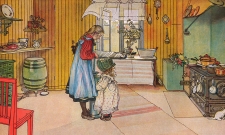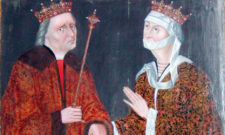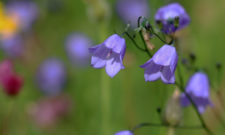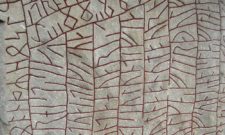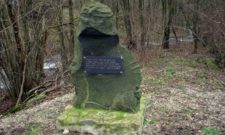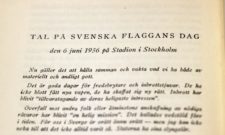Shop our historical maps
Culture
Carl Larsson (1853-1919) - One of our most popular artists
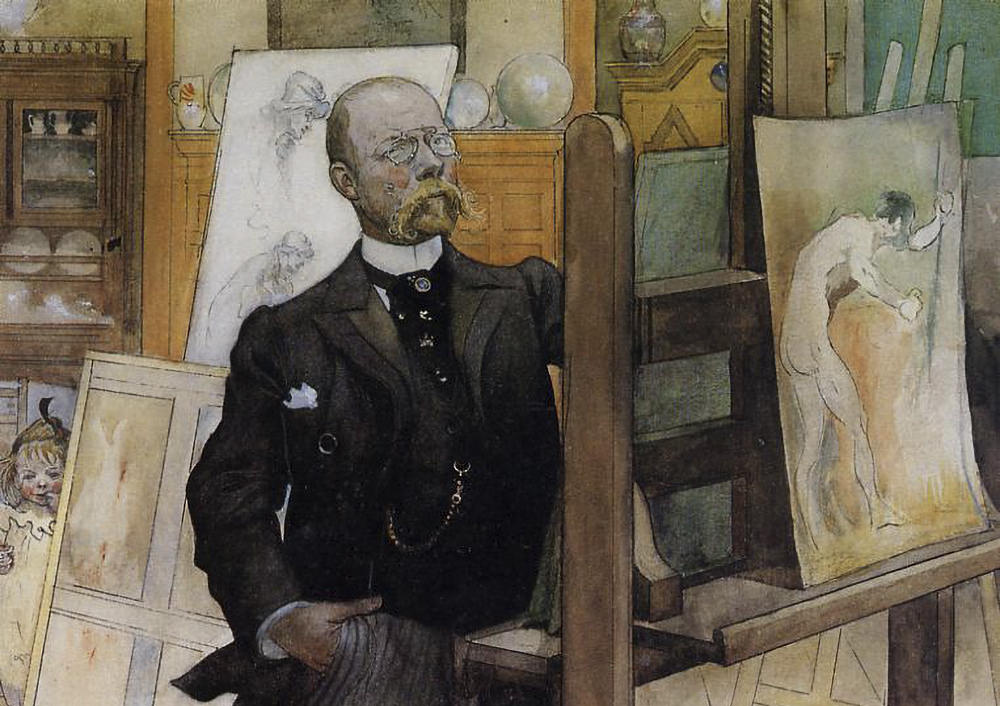
May
Carl Larsson (1853-1919) is perhaps our most popular artist and one of the world's greatest watercolourists. He is best known for his depiction of idyllic family life, both everyday and festive.
Carl Larsson was born on 28 May 1853 and grew up in Stockholm's simpler neighbourhoods. His artistic talent became apparent early on and at the age of 13 he was recommended by a teacher to apply to the preparatory department of the Academy of Fine Arts. At the age of 16, he was accepted into the Academy of Fine Arts, where he studied until 1876. At the same time, he earned an income by working as a retoucher. After completing his studies, he made a living by producing illustrations for newspapers, magazines and books, including H.C. Andersen's fairy tales and Anna Maria Lenngren's poems. He also spent several years in France, where he lived a poor life while trying unsuccessfully to establish himself as an artist.
In 1882 the painter Karl Nordström took Carl to the Scandinavian artists' colony in Grez-sur-Loing south of Paris. There, both his life and his art took a new direction. In Grez he met his future wife, the artist Karin Bergöö, and fell deeply in love. At the same time, he switched from heavy oil paintings to a much more airy open-air painting in watercolour. His serene and bright style was soon discovered by a wide audience and was much appreciated. In 1883 he was a success at the Paris Salon and was awarded a medal.

In 1883 Carl Larsson married Karin Bergöö, and the growing family became a constant source of inspiration for new motifs. In total they had eight children. The couple first lived in France, but returned to Sweden in 1885. After returning home, Carl helped found the Opponents movement, which promoted a reformation of the Art Academy's archaic teaching. When they failed to gain support, the Swedish Association of Artists was formed with Carl as a board member. At the same time, a boom in the economy caused art to flourish. Carl was widely commissioned and was part of a circle of the country's most popular artists. Among his friends were Anders Zorn and Bruno Liljefors. Carl also hung out with the outspoken August Strindberg, but their friendship broke down when they developed different political views.
During these years, Carl developed his characteristic painting style with detailed and somewhat stylised motifs. The marked contours are combined with clear colour fields. The style clearly went against earlier trends and attracted some criticism, but Carl continued to gain increasing recognition and his fan base grew.
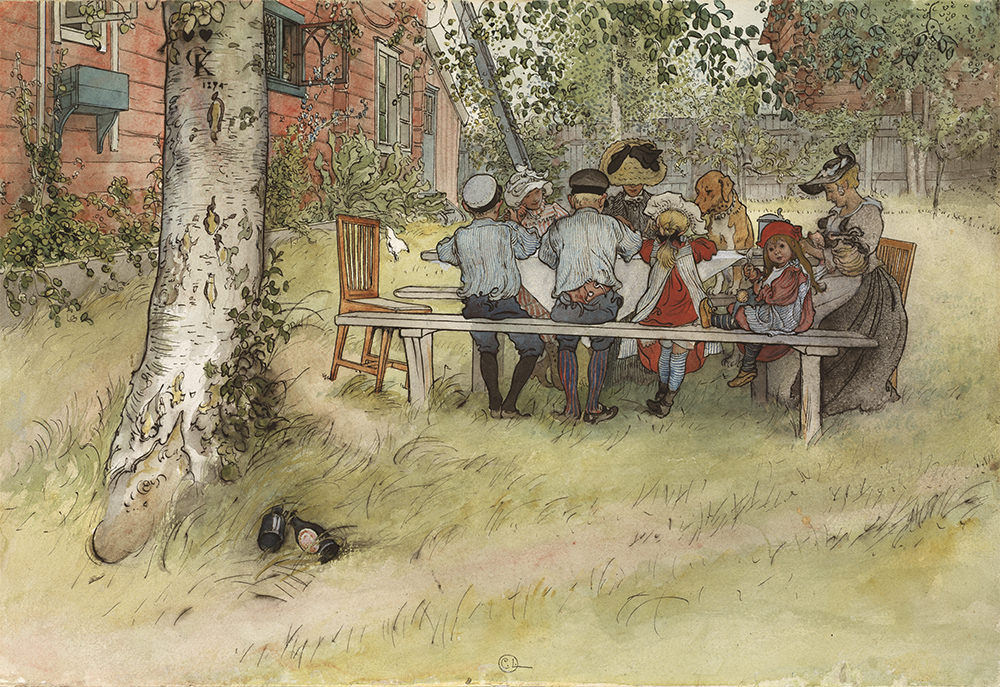
In 1886 Carl was appointed director of the Gothenburg Museum Art School, where he remained until 1891. The family then left Gothenburg and moved to Stockholm. At the same time, the renovation of Lilla Hyttnäs in Sundborn, which the couple had received as a gift from Karin's father, was underway. Sundborn first served as a summer residence, but in 1901 it became the family's permanent home. The house was given a personal interior with bold combinations of colours and styles for the time. There Carl an abundance of motifs with family and rural charm at its heart. His paintings of the colourful home were published in books that spread throughout Europe, making him popular even beyond Sweden's borders.
Although Carl became known primarily as an artist of domestic and family life, he also devoted himself to portraiture. He was also commissioned to paint frescoes in public buildings. Among other things, he was commissioned to decorate the foyers of the Royal Opera and the Dramatic Theatre.
The latter part of Carl Larsson's life came to revolve around one of the most controversial works in Swedish art history, the 80-square-metre "Midwinterblot". The long-running controversy began when the National Museum's mural committee announced a competition to decorate the museum's stairwell. After competition entries were rejected, the competition was redrawn and the results debated for several years, Carl Larsson finally emerged as the winner. However, for the upper stairwell he insisted on an Old Norse motif with a pagan sacrificial ceremony, which was considered distasteful and created a storm of protest. When the proposal was rejected, Carl instead completed the painting at home in his artist's studio, but the National Museum continued to refuse it a place. The rejection took Carl Larsson very hard, and in the autobiography he completed a few days before his death, he stated that Midvinterblot's fate had broken him.

Carl Larsson is now regarded as one of our foremost National Romantic artists and one of the greatest watercolourists in art history. His depictions have made Sundborn one of the world's most famous artist's homes and have contributed greatly to the image of Sweden. Many of his subjects have been recreated in a wide variety of contexts and are generally familiar to a Swedish audience. It is no exaggeration to say that Carl Larsson's work has shaped part of the Swedish self-image.
Footnote: In 1997, with the help of money from various foundations and donations, the National Museum was able to purchase Midwinter's Blossom from the Japanese art collector who owned the painting. The price at the time was SEK 14.6 million. Now the work of art can be seen in the place Carl Larsson wished.
Print sources:
Alfons, Harriet and Alfons, Sven (1977), Carl Larsson: portrayed by himself, Albert Bonniers Publishers
Larsson, Carl (1975), A home on the sunny side, Albert Bonniers Publishers
Unprinted sources:
http://popularhistoria.se/artiklar/carl-larssons-liv-var-langt-ifran-en-idyll
http://www.visitdalarna.se/sv/sodradalarna/gora/sevardheter/carl-larssongarden/
First published at Cultural memory.
Subscribe to YouTube:
If you appreciate Allmogens independent work to portray our fine Swedish history and Nordic culture, you are welcome to buy something nice in the shop or support us with a voluntary donation. Thank you in advance!
Support Allmogens via Swish: 123 258 97 29
Support Allmogens by becoming a member
Support Allmogens in your will
Popular
Allmoge - what is it?
The slaughter of the almages on Helgeandsholmen 1463
How to renovate old windows step by step
Culture
The plague in the Gullspång river
Small bluebell voted Sweden's national flower
Smokestone (Eye 136)
25 March 1644: Massacre of Scanian peasants at the Battle of Borst
Speech on Swedish Flag Day
